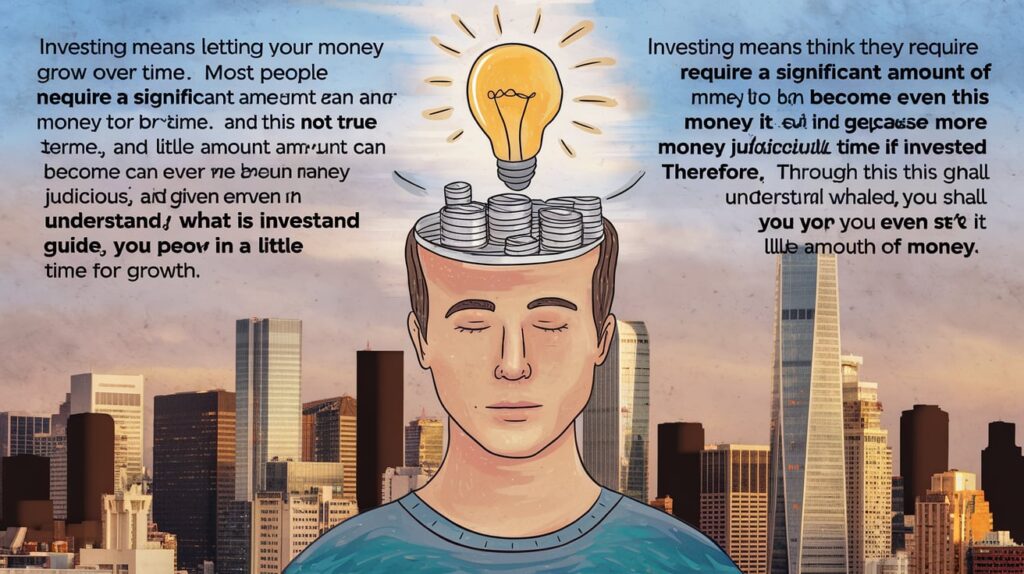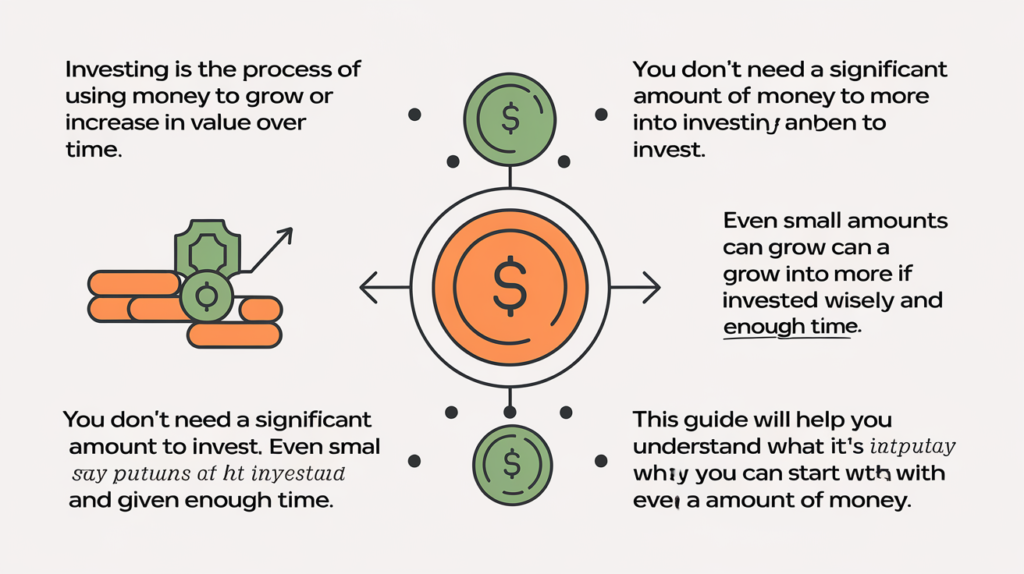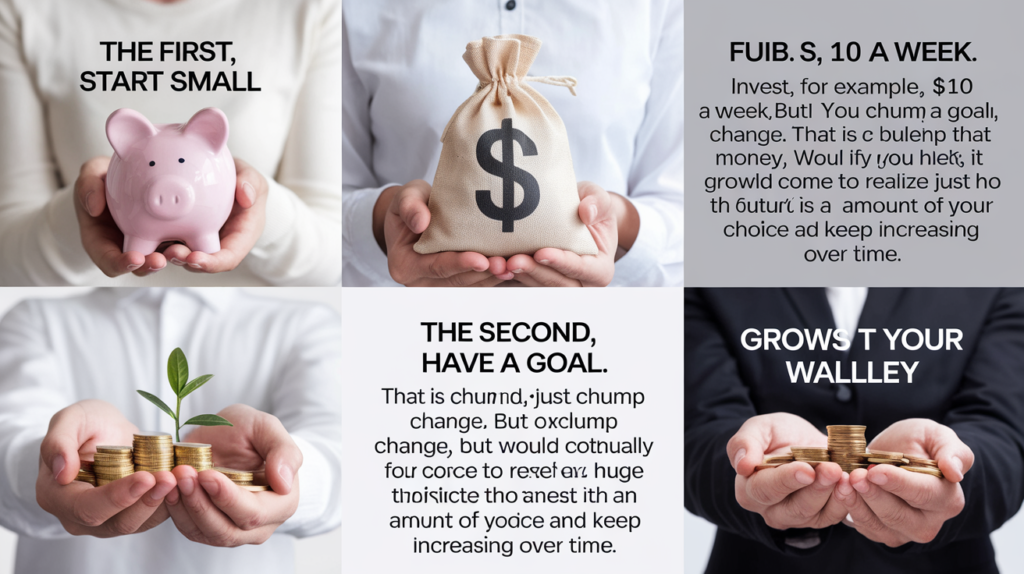Investing for Beginners: Start Small and Grow Big
Introduction
Invest means letting your money grow over time. Most people think they require a significant amount of money to be invested, and this is not true because a little amount can become even more money if invested judiciously and given appropriate time for growth. Therefore, through this guide, you shall understand what is investing, why it should be invested, and in what form you can even start it with little amount of money.

Chapter 1: What is Investing?
What is an Investment?
An investment is something you buy with the hope that its value will increase over time. When the value goes up, you can sell it for more than you paid, and that difference is your profit.
Why Do People Invest?
People invest in order to earn their desired goals. You might perhaps want to buy a house someday or save your money for retirement, maybe just having some for your family. You then increase your money by working less hard.
Chapter 2: Types of Investments
Humans tend to invest for some motive, whether it’s for buying that dream house, possibly saving for retirement, or merely just to have spare money for the family and here’s where investing can kick in-growth of wealth without an increase in your work hours.

1. Stocks
Equities are stocks. Purchasing a stock is the same as buying a portion of that business. Therefore, when that particular company flourishes, the value of that particular stock will probably rise and you collect the profits. When the performance of that company declines, the value of that specific stock may fall and cause losses.
2. Bonds
A bond is just a loan advanced to either a company or government promised to be repaid over a specified period with some interest attached. They are safer than stocks in that you will get your pay, but the rate you are earning will be smaller.
3. Mutual Funds and ETFs
In reality, a mutual fund is merely an accumulation of many other various investments, such as stocks and bonds. Thousands of individuals contribute their money, and the manager decides which investments to use for the collective group. An ETF stands for exchange-traded fund. It is basically the same idea but you can purchase and sell it as if it were a stock. Such funds diversify your money, thus lowering your risk.
4. Savings Accounts and CDs
Savings accounts and CDs are an extremely safe and sound place. These are available through banks, and they offer low-risk options. The returns are not going to be anything large, but these accounts are extremely safe places to hold money you just want protected.
Chapter 3: How to Start Investing with Small Money
You don’t need a lot of money to start investing. Here are some easy steps to begin:
1. Set Small Goals
The second, have a goal: invest, for example, $10 a week. That is chump change, but if you continually save that money, you would come to realize just how huge it grows into in the future. Once again, start with an amount of your choice and keep increasing over time.

2. Use Investment Apps
Most apps today allow you to invest with as little as $1. Popular investment apps include Robinhood, Acorns, or Stash, and these are relatively easy to use. It’s possible to even buy small pieces of stock at relatively affordable prices.
3. Try Robo-Advisors
Robo-advisors are online services that can give people automatic investment management. They ask you a few questions regarding your goals after which they decide upon investments for you. Robo-advisors are therefore good for beginners who may not know much about investments.
Chapter 4: Understanding Risk
It is the possibility that an investment may lose value. Of course, all investments carry some level of risk; the risk varies, though.

Why Risk is Part of Investing
When you invest, you are taking a risk. Sometimes the money you put your money on may rise but may decrease in value completely. It is through the shares that will take you to a good banking account since you are bound to see how they deflate very soon. Inversely, bonds do not grow too fast in their value, but it will be better to go into it with a safer perspective about the cash.
How to Manage Risk
Avoidance of risk is the best diversification, that means putting all your eggs into a different basket. The money may be put entirely in a mix of stocks, bonds, and mutual funds instead of putting everything in stocks. That is, bad performance by one investment will be offset by some good ones.
Chapter 5: Making Your First Investment
1. Opening an Account
To invest, you have to open an account; the kind of account decides how you will be going to invest. You will find this account at the banks or any investment company and some of the few banking institutions may have some minuscule fees while applications are free, so do pick your way.

2. Choosing Your First Investment
The simplest of all is the beginning point. Many small-time investors like to use mutual funds or ETFs as they are less volatile when compared to buying stocks in individual names. There’s also “index funds” which are a sort of mutual fund that is invested based on the performance of large numbers of stocks such as the S&P 500.
3. Tracking Your Investment
Once you deposit it is quite nice to go through your deposits sometimes then you would be in a position to see how money multiplies and understand your investment better. Try to look at them only occasionally for sometimes investments tend to shift positions every day. So what?
FAQs
1. What is a good age to start investing? You can start investing at any age. The earlier you start, the more time your money has to grow.
2. Do I need a lot of money to invest? No, you don’t need a lot of money. You can start with a small amount, even as little as $1 with some apps.
3. Can I lose money investing? Yes, you can lose money, especially with high-risk investments. But by diversifying and starting small, you can manage your risk.
4. How much should I invest as a beginner? Start with what you can afford. Even $10 a week can grow over time.
5. Are there any ‘safe’ investments? Savings accounts, CDs, and some government bonds are safe but don’t grow as fast as other investments. These are good for money you want to keep safe.
Conclusion: Start Now and Stay Patient
Investing can be a journey. You might not see big changes overnight, but small steps today can lead to a better financial future. Remember, the goal is to grow over time, not to get rich quickly. Stay patient, keep learning, and watch as your money starts to grow!




